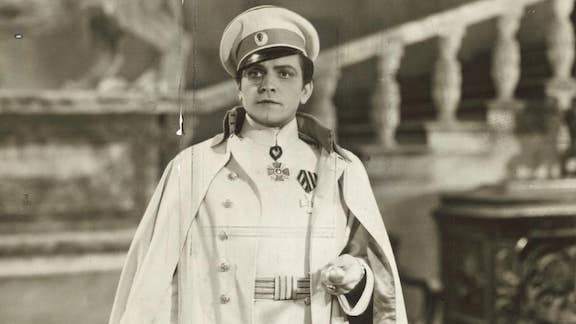To acquire a DVD copy of one of my favorite movies, Death Takes a Holiday (1934), I had to buy the 1998 remake, Meet Joe Black: The Ultimate Edition. I ordered a used copy, figuring that whereas the DVD of the new film, which stars Brad Pitt, might well be “scratched” from frequent use, the bonus disc, with the Fredric March original, would probably be flawless. Mr. Pitt’s young fans don’t like old black-and-white movies — one reason why the older film isn’t out on DVD by itself. (2010 Update: It is now. And in several formats, including streaming.)
Watching the new version and then the older hints at how views of death have changed in less than a century.
Death Takes a Holiday, adapted from Alberto Casella’s 1924 play, La Morta in Vacanza, is the story of Death’s decision to take a few days off. When we first meet him, Death is a shadowy, faceless figure come to the estate of Duke Lambert (Guy Standing), not to take the duke’s soul but to seek knowledge: “There is something about me that men fear,” Death says, “and that makes them cling to their existence. I must find out what it is.” So he assumes the human form of one Prince Sirki, recently deceased.
Death falls in love — with the duke’s prospective daughter-in-law, Grazia (Evelyn Venable) — and while he sojourns as Prince Sirki, nothing dies. The guns of war jam and accident victims are unhurt. A jilted lover jumps off the Eifel Tower, gets up, and walks away. Probably off to a café for a glass of eau-de-vie!
Serio-fantasy is the name usually given as the film’s genre, but you might better call it Catholic realism. In its title-sequence/prologue the various characters, Lambert’s wealthy friends, are in an Italian village buying armloads of flowers. The duke’s son, Corrado, played by square-jawed Kent Taylor (who’s first name became the last name of Superman’s alter ego — whereas the “Clark” of Clark Kent came from Clark Gable), goes looking for Grazia and finds her in church. She has finished praying the rosary and is making the sign of the cross. And there are other Catholic signs too. The duke’s mansion is called Villa Felicità; his servant is named Fedele: the words in Italian meaning respectively happinesss (or contentment) and faithful. At one of the duke’s galas, a cardinal attends in full regalia. This is the milieu in which Grazia and Sirki meet.
Grazia is self-possessed yet discontented in this world, very much a woman in search of a religious vocation. Her yearning unsettles friends and family. “There’s something miraculous in the air,” she explains. “Like an old story you can’t quite believe.” Except she does believe it, even though, when Death first touches her, she faints.

As Death/Prince Sirki, Fredric March shows why he was one of old Hollywood’s most intriguing movie stars. In the remake, Brad Pitt’s Death (also secreted in a fresh body, this one called Joe Black) seems like the starchild of Stanley Kubrick’s 2001 suddenly grown up but blinking with fawn-like astonishment at his new world. He doesn’t even know how to tie a necktie.
Mr. March, on the other hand, has his utterly confident Sirki (always elegantly dressed) radiate both civility and menace. Joe Black is a brooding, uncultured — albeit blond and attractive — wild boy who has stumbled uninvited among the sophisticated set, whereas Sirki is every inch a prince — debonair and bold — attractive, yes, but awe-inspiring too.
Grazia and Sirki dance. Corrado intervenes; he senses her wish to renounce this world. In their last earthly moments, Sirki tells her: “I am a great power, and I am humble before you.” Her faith has conquered Death, and Sirki offers Grazia an unimaginable journey.
Joe Black seems rather more inclined to offer his Susan (Claire Forlani) a weekend trip to Motel 6, their union being not merely spiritual. When they have a happy ending, it’s only because Death has vacated and stuffed back the original soul into the body of “Joe Black.” Susan seems okay with this, since, unlike Grazia, she’s not necessarily looking for commitment. Besides, her Death was about as vacuous as Joe.
No cardinal attends the big party for her father (Anthony Hopkins); no priests either and certainly no prayers are said.
Sirki calls himself a “familiar friend,” but in the world of Joe Black death is an odd stranger, if not an alien enemy. Folks these days expect long lives and are scandalized by early death. To many people, it seems positively ghoulish that Victorians photographed their dead children and kept the pictures as treasured mementos. But until this century, death touched humanity at every age, and survivors were sustained by faith — not so much by the dance and trance of pleasure.
Death, personified, isn’t per se Christian of course. He’s a force of nature, like waves breaking on a winter beach or the wind that whips those waves and fills the sails of ships in storms.
This is why Catholics do not fear him; our fears, if we have them, are biological. Eschatologically, we know storms blow our ships to a heavenly port.














